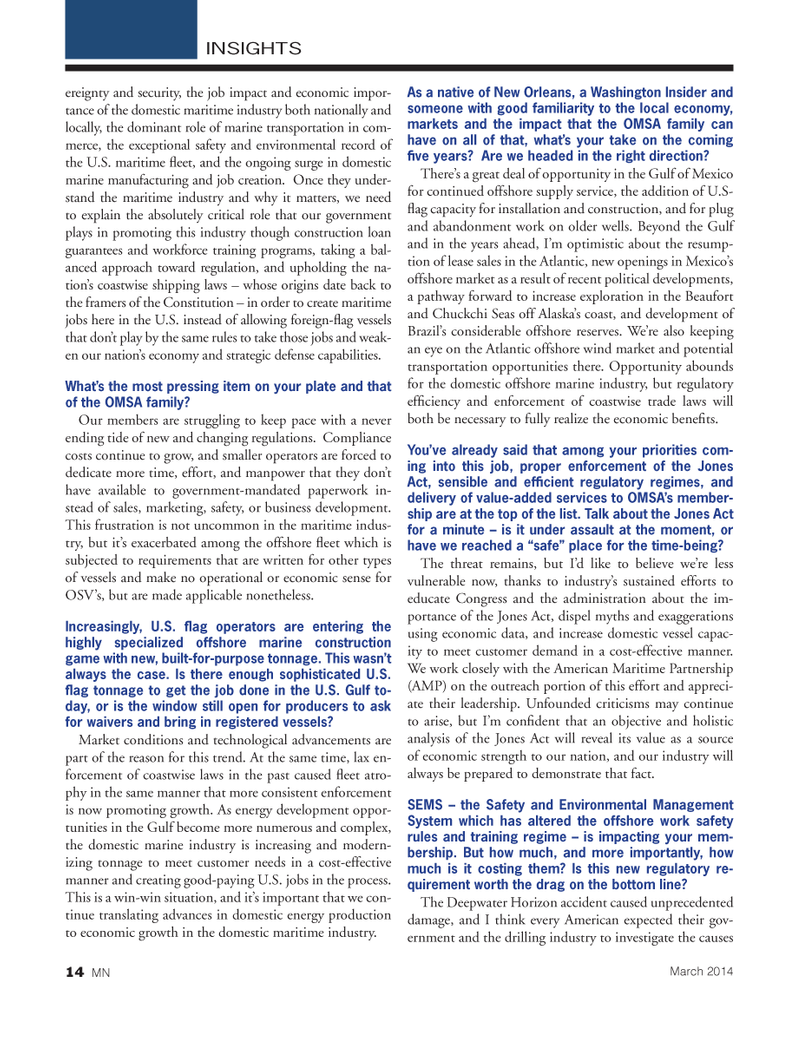
Page 14: of Marine News Magazine (March 2014)
Fleet & Vessel Optimization
Read this page in Pdf, Flash or Html5 edition of March 2014 Marine News Magazine
ereignty and security, the job impact and economic impor- tance of the domestic maritime industry both nationally and locally, the dominant role of marine transportation in com- merce, the exceptional safety and environmental record of the U.S. maritime fl eet, and the ongoing surge in domestic marine manufacturing and job creation. Once they under- stand the maritime industry and why it matters, we need to explain the absolutely critical role that our government plays in promoting this industry though construction loan guarantees and workforce training programs, taking a bal- anced approach toward regulation, and upholding the na- tion’s coastwise shipping laws – whose origins date back to the framers of the Constitution – in order to create maritime jobs here in the U.S. instead of allowing foreign-fl ag vessels that don’t play by the same rules to take those jobs and weak- en our nation’s economy and strategic defense capabilities.
What’s the most pressing item on your plate and that of the OMSA family?
Our members are struggling to keep pace with a never ending tide of new and changing regulations. Compliance costs continue to grow, and smaller operators are forced to dedicate more time, effort, and manpower that they don’t have available to government-mandated paperwork in- stead of sales, marketing, safety, or business development.
This frustration is not uncommon in the maritime indus- try, but it’s exacerbated among the offshore fl eet which is subjected to requirements that are written for other types of vessels and make no operational or economic sense for
OSV’s, but are made applicable nonetheless.
Increasingly, U.S. fl ag operators are entering the highly specialized offshore marine construction game with new, built-for-purpose tonnage. This wasn’t always the case. Is there enough sophisticated U.S. fl ag tonnage to get the job done in the U.S. Gulf to- day, or is the window still open for producers to ask for waivers and bring in registered vessels?
Market conditions and technological advancements are part of the reason for this trend. At the same time, lax en- forcement of coastwise laws in the past caused fl eet atro- phy in the same manner that more consistent enforcement is now promoting growth. As energy development oppor- tunities in the Gulf become more numerous and complex, the domestic marine industry is increasing and modern- izing tonnage to meet customer needs in a cost-effective manner and creating good-paying U.S. jobs in the process.
This is a win-win situation, and it’s important that we con- tinue translating advances in domestic energy production to economic growth in the domestic maritime industry.
As a native of New Orleans, a Washington Insider and someone with good familiarity to the local economy, markets and the impact that the OMSA family can have on all of that, what’s your take on the coming fi ve years? Are we headed in the right direction?
There’s a great deal of opportunity in the Gulf of Mexico for continued offshore supply service, the addition of U.S- fl ag capacity for installation and construction, and for plug and abandonment work on older wells. Beyond the Gulf and in the years ahead, I’m optimistic about the resump- tion of lease sales in the Atlantic, new openings in Mexico’s offshore market as a result of recent political developments, a pathway forward to increase exploration in the Beaufort and Chuckchi Seas off Alaska’s coast, and development of
Brazil’s considerable offshore reserves. We’re also keeping an eye on the Atlantic offshore wind market and potential transportation opportunities there. Opportunity abounds for the domestic offshore marine industry, but regulatory effi ciency and enforcement of coastwise trade laws will both be necessary to fully realize the economic benefi ts.
You’ve already said that among your priorities com- ing into this job, proper enforcement of the Jones
Act, sensible and effi cient regulatory regimes, and delivery of value-added services to OMSA’s member- ship are at the top of the list. Talk about the Jones Act for a minute – is it under assault at the moment, or have we reached a “safe” place for the time-being?
The threat remains, but I’d like to believe we’re less vulnerable now, thanks to industry’s sustained efforts to educate Congress and the administration about the im- portance of the Jones Act, dispel myths and exaggerations using economic data, and increase domestic vessel capac- ity to meet customer demand in a cost-effective manner.
We work closely with the American Maritime Partnership (AMP) on the outreach portion of this effort and appreci- ate their leadership. Unfounded criticisms may continue to arise, but I’m confi dent that an objective and holistic analysis of the Jones Act will reveal its value as a source of economic strength to our nation, and our industry will always be prepared to demonstrate that fact.
SEMS – the Safety and Environmental Management
System which has altered the offshore work safety rules and training regime – is impacting your mem- bership. But how much, and more importantly, how much is it costing them? Is this new regulatory re- quirement worth the drag on the bottom line?
The Deepwater Horizon accident caused unprecedented damage, and I think every American expected their gov- ernment and the drilling industry to investigate the causes
INSIGHTS 14 MN
March 2014
MN MAR14 Layout 1-17.indd 14 2/21/2014 3:17:31 PM

 13
13

 15
15
